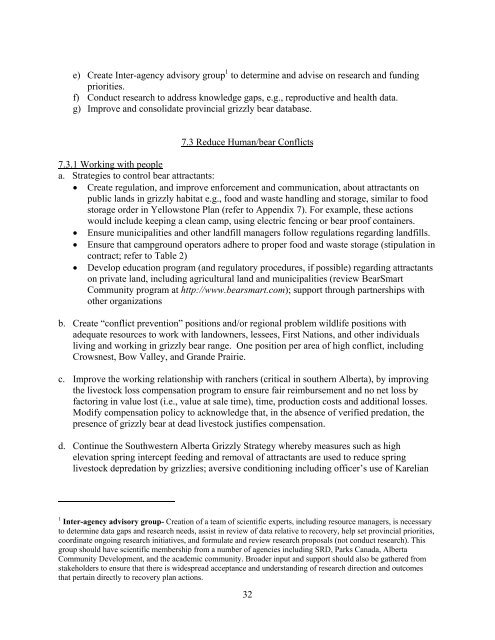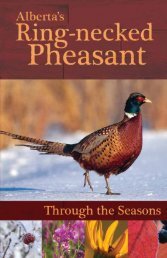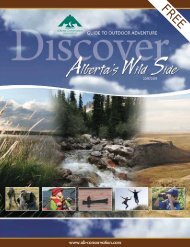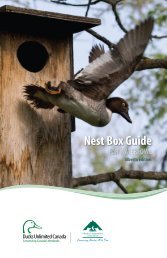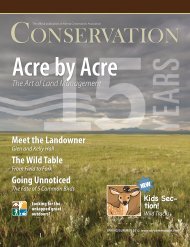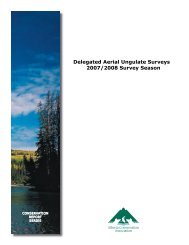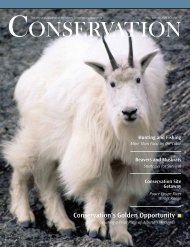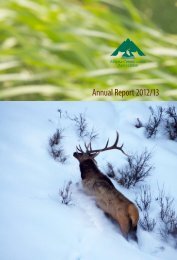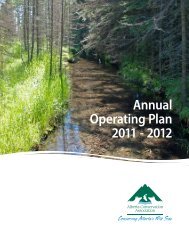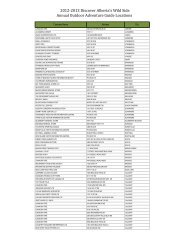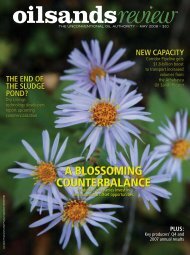Alberta Grizzly Bear Recovery Plan 2008-2013 - Alberta Sustainable ...
Alberta Grizzly Bear Recovery Plan 2008-2013 - Alberta Sustainable ...
Alberta Grizzly Bear Recovery Plan 2008-2013 - Alberta Sustainable ...
Create successful ePaper yourself
Turn your PDF publications into a flip-book with our unique Google optimized e-Paper software.
e) Create Inter-agency advisory group 1 to determine and advise on research and funding<br />
priorities.<br />
f) Conduct research to address knowledge gaps, e.g., reproductive and health data.<br />
g) Improve and consolidate provincial grizzly bear database.<br />
7.3 Reduce Human/bear Conflicts<br />
7.3.1 Working with people<br />
a. Strategies to control bear attractants:<br />
• Create regulation, and improve enforcement and communication, about attractants on<br />
public lands in grizzly habitat e.g., food and waste handling and storage, similar to food<br />
storage order in Yellowstone <strong>Plan</strong> (refer to Appendix 7). For example, these actions<br />
would include keeping a clean camp, using electric fencing or bear proof containers.<br />
• Ensure municipalities and other landfill managers follow regulations regarding landfills.<br />
• Ensure that campground operators adhere to proper food and waste storage (stipulation in<br />
contract; refer to Table 2)<br />
• Develop education program (and regulatory procedures, if possible) regarding attractants<br />
on private land, including agricultural land and municipalities (review <strong>Bear</strong>Smart<br />
Community program at http://www.bearsmart.com); support through partnerships with<br />
other organizations<br />
b. Create “conflict prevention” positions and/or regional problem wildlife positions with<br />
adequate resources to work with landowners, lessees, First Nations, and other individuals<br />
living and working in grizzly bear range. One position per area of high conflict, including<br />
Crowsnest, Bow Valley, and Grande Prairie.<br />
c. Improve the working relationship with ranchers (critical in southern <strong>Alberta</strong>), by improving<br />
the livestock loss compensation program to ensure fair reimbursement and no net loss by<br />
factoring in value lost (i.e., value at sale time), time, production costs and additional losses.<br />
Modify compensation policy to acknowledge that, in the absence of verified predation, the<br />
presence of grizzly bear at dead livestock justifies compensation.<br />
d. Continue the Southwestern <strong>Alberta</strong> <strong>Grizzly</strong> Strategy whereby measures such as high<br />
elevation spring intercept feeding and removal of attractants are used to reduce spring<br />
livestock depredation by grizzlies; aversive conditioning including officer’s use of Karelian<br />
1 Inter-agency advisory group- Creation of a team of scientific experts, including resource managers, is necessary<br />
to determine data gaps and research needs, assist in review of data relative to recovery, help set provincial priorities,<br />
coordinate ongoing research initiatives, and formulate and review research proposals (not conduct research). This<br />
group should have scientific membership from a number of agencies including SRD, Parks Canada, <strong>Alberta</strong><br />
Community Development, and the academic community. Broader input and support should also be gathered from<br />
stakeholders to ensure that there is widespread acceptance and understanding of research direction and outcomes<br />
that pertain directly to recovery plan actions.<br />
32


